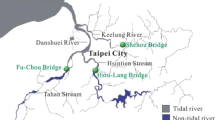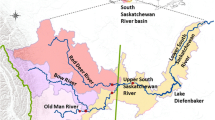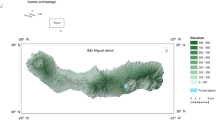Abstract
A coupled three-dimensional hydrodynamic–ecological model was used for the assessment of water quality in Narva Bay during one biologically active season. Narva Bay is located in the south-eastern Gulf of Finland. Narva River with a catchment’s area covering part of Russia and Estonia discharges water and nutrients to Narva Bay. The ecological model includes phytoplankton carbon, nitrogen and phosphorus, chlorophyll a, zooplankton, detritus carbon, nitrogen and phosphorus, inorganic nitrogen, inorganic phosphorus and dissolved oxygen as state variables. Both the hydrodynamic and ecosystem models were validated using a limited number of measurements. The hydrodynamic model validation included comparison of time series of currents and temperature and salinity profiles. The ecological model results were compared with the monitoring data of phytoplankton biomass, total nitrogen and phosphorus and dissolved oxygen. The comparison of hydrodynamic parameters, phytoplankton biomass, surface layer total phosphorus and dissolved oxygen and near-bottom layer total nitrogen was reasonable. Time series of spatially mean values and standard deviations of selected parameters were calculated for the whole Narva Bay. Combining model results and monitoring data, the characteristic concentrations of phytoplankton biomass, total nitrogen and phosphorus and near-bottom dissolved oxygen were estimated. Phytoplankton biomass and total phosphorus showed seasonal variations, of 0.6–1.1 and 0.022–0.032 mg/l, respectively, during spring bloom, 0.1–0.3 and 0.015–0.025 mg/l in summer and 0.2–0.6 and 0.017–0.035 mg/l during autumn bloom. Total nitrogen and near-bottom oxygen concentrations were rather steady, being 0.25–0.35 and 2–6 mg/l, respectively. The total nitrogen and phosphorus concentrations show that according to the classification of Estonian coastal waters, Narva Bay water belongs to a good water quality class.
Similar content being viewed by others
References
Andrejev, O., Myrberg, K., Alenius, P., & Lundberg, P. A. (2004). Mean circulation and water exchange in the Gulf of Finland – a study based on three-dimensional modelling. Boreal Environment Research, 9, 1–16.
Boyer, J. N., Sterling, P., & Jones, R. D. (2000). Maximizing information from a water quality monitoring network through visualization techniques. Estuarine, Coastal and Shelf Science, 50, 39–48.
Burchard, H., Petersen, O., & Rippeth, T. P. (C5, 1998). Comparing the performance of the Mellor–Yamada and the k–ɛ two-equation turbulence models. Journal of Geophysical Research, 10388, 10.543–10.554.
Comim, F. A., Menemdez, M., & Herrera, J. A. (2004). Spatial and temporal scales for monitoring coastal aquatic ecosystems. Aquatic Conservation – Marine and Freshwater Ecosystems 14.
S. Cozzi, G. Adami, P. Barbieri, C. Cantoni, G. Catalano, F. Crisciani, V., et al. (2004). Matching monitoring and modelling in the Gulf of Trieste. Marine Pollution Bulletin, 48, 587–592.
DHI Water and Environment (2001). MIKE 3: environmental hydraulics. DHI Software User Guide, Documentation and Reference Manual.
Edelvang, K., Kaas, H., Erichsen, A. C., Alvarez-Berastegui, D., Bundgaard, K., & Jørgensen, P. V. (2005). Numerical modelling of phytoplankton biomass in coastal waters. Journal of Marine Systems, 57, 13–29.
Erichsen, A. C., & Rasch, P. S. (2001). Two- and three-dimensional model system predicting the water quality of tomorrow. In Proceedings of the Seventh International Conference on Estuarine and Coastal Modeling. American Society of Civil Engineers.
EU (2000). Council Directive of 23 October 2002. Establishing a framework for community action in the field of water policy (2000/60/EC). Official Journal of the European Communities, L327, 22 December.
HELCOM (2002). Environment of the Baltic Sea Area 1994–1998. Balt. Sea Environ. Proc. No. 82B.
Kauppila, P., Meeuwig, J. J., & Pitkänen, H. (2003). Predicting oxygen in small estuaries of the Baltic Sea: A comparative approach. Estuarine, and Coastal Shelf Science, 57, 1115–1126.
Kiirikki, M., Haapanmäki, J., Koponen, J., Ruuskanen, A., & Sarkkula, J. (1998). Linking the growth of filamentous algae to the 3D-ecohydrodynamic model of the Gulf of Finland. Environmental Modeling & Software, 13, 503–509.
Kiirikki, M., Inkala, A., Kuosa, H., Pitkänen, H., Kuusisto, M., & Sarkkula, J. (2001). Evaluating the effects of nutrient load reductions on the biomass of toxic nitrogen-fixing cyanobacteria in the Gulf of Finland, Baltic Sea. Boreal Environment Research, 6, 131–146.
Kim, L.-H., Choi, E., & Stenstrom, M. K. (2003). Sediment characteristics, phosphorus types and phosphorus release rates between river and lake sediments. Chemosphere, 50, 53–61.
Kuusisto, M., Koponen, J., & Sarkkula, J. (1998). Modelled phytoplankton dynamics in the Gulf of Finland. Environmental Modeling & Software, 13, 461–470.
Lips, U. (2005). Typology and classification system for Estonian coastal waters. Proceedings of Estonian Maritime Academy, 2, 62–74.
Losa, S. N., Kivman, G. A., Schröter, J., & Wenzel, M. (2003). Sequential weak constraint parameter estimation in an ecosystem model. Journal of Marine Systems, 43, 31–49.
Morris, I. (1986). The physiological ecology of phytoplankton. Studies in Ecology, 7. Blackwell Scientific Publications.
Palmén, E. (1930). Untersuchungen über die Strömungen in den Finnland umgebenden Meeren, Societas Scientiarum Fennica. Commentationes Physico-Mathematicae, 5, 1–93.
Petihakis, G., Triantafyllou, G., Pollani, A., Koliou, A., & Theodorou, A. (2005). Field data analysis and application of a complex water column biogeochemical model in different areas of a semi-enclosed basin: Towards the development of an ecosystem management tool. Marine Environmental Research, 59, 493–518.
Piirsoo, K., Porgasaar, V., & Viik, M. (1992). Environmental conditions, phytoplankton and chlorophyll a in the Narva Bay (the southern part of the Gulf of Finland). Proceedings of the Estonian Academy of Sciences. Biology, 41, 149–161.
Rasmussen, E. B. (1993). Three-dimensional hydrodynamic models. Section 3.1 hydrodynamic models. In M. B. Abbot & N. A. Price (Eds.), Coastal, Estuarine and Harbour Engineer's Reference Book. Chapman and Hall, 109–116.
Rasmussen, E. B., Pietrzak, J., & Brandt, R. (1999). A coupled ice-ocean model for the Greenland, Iceland and Norwegian Seas. Deep-Sea Research Part II, 46, 1169–1198.
Stålnacke, P., Grimvall, A., Sundblad, K., & Tonderski, A. (1999). Estimation of riverine loads of nitrogen and phosphorus to the Baltic Sea, 1970–1993. Environmental Monitoring and Assessment, 58, 173–200.
Tamsalu, R., & Ennet, P. (1995). Ecosystem modelling in the Gulf of Finland. II. The aquatic ecosystem model FINEST. Estuarine, Coastal and Shelf Science, 41, 429–458.
Telesh, I.V. (2004). Plankton of the Baltic estuarine ecosystems with emphasis on Neva Estuary: A review of present knowledge and research perspectives. Marine Pollution Bulletin, 49, 206–219.
Valiela, I. (1984). Marine ecological processes. Berlin Heidelberg New York: Springer-Verlag.
Zonneveld, C. (1998). A cell-based model for the chlorophyll a to carbon ratio in phytoplankton. Ecological Modeling, 113, 55–70.
Author information
Authors and Affiliations
Corresponding author
Rights and permissions
About this article
Cite this article
Lessin, G., Raudsepp, U. Water quality assessment using integrated modeling and monitoring in Narva Bay, Gulf of Finland. Environ Model Assess 11, 315–332 (2006). https://doi.org/10.1007/s10666-006-9045-7
Received:
Accepted:
Published:
Issue Date:
DOI: https://doi.org/10.1007/s10666-006-9045-7




